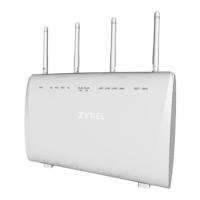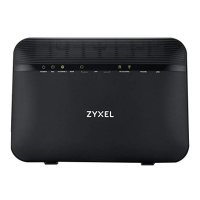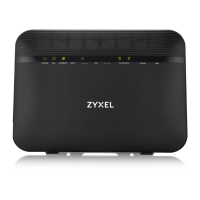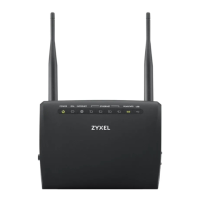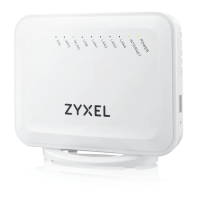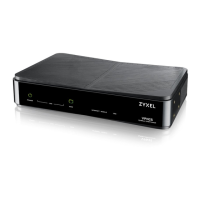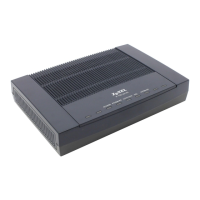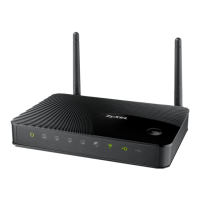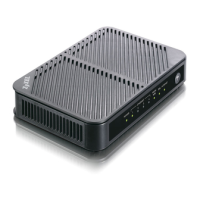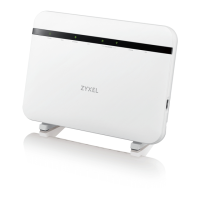
Do you have a question about the ZyXEL Communications VMG8825-B Series and is the answer not in the manual?
| Model | VMG8825-B Series |
|---|---|
| Category | Network Router |
| Operating Temperature | 0°C to 40°C (32°F to 104°F) |
| Wireless Standard | 802.11 a/b/g/n/ac |
| Frequency Bands | 2.4 GHz, 5 GHz |
| LAN Interface | 4 x Gigabit Ethernet ports |
| USB Ports | USB 2.0 |
| DSL Standards | VDSL2, ADSL2+, ADSL2, ADSL |
| Security | WPA/WPA2 |
| Humidity | 10% to 90% non-condensing |
Provides a general introduction to the VMG, its capabilities, and supported technologies like VDSL and Ethernet.
Explains how to connect the VMG for internet access via DSL or Ethernet WAN ports.
Details how to reset the VMG to factory default settings using the physical RESET button.
Introduces the HTML-based management interface for VMG setup and management via a web browser.
Guides users on how to launch the web browser and log into the VMG's web configurator.
Explains the layout and function of the navigation panel for configuring VMG features.
Introduces the Quick Start screens for configuring time zone, internet access, and wireless settings.
Provides a step-by-step guide for the initial setup of the VMG using the Quick Start wizard.
Introduces various features of the VMG that will be covered in the tutorials section.
Guides users through setting up an ADSL Internet connection using the Web Configurator.
Explains how to configure wireless network settings for secure access using WPS or manual configuration.
Details how to configure MAC address filtering to control wireless access to the VMG.
Introduces the Network Map and Status screens for monitoring network connection status.
Describes how to view the VMG's status, system resources, and interface information.
Introduces the VMG's Broadband screens for configuring Internet access.
Explains how to manage WAN interfaces and configure internet access settings on the VMG.
Details how to enable or disable ADSL over PTM, Annex M, DSL PhyR, and SRA functions.
Introduces the VMG's Network Setting > Wireless screens for setting up wireless connection.
Guides users to enable Wireless LAN, set SSID, and select wireless security mode.
Explains how to configure WPA2-PSK security mode for improved data encryption and user authentication.
Details how to configure WiFi Protected Setup (WPS) for quick wireless network setup.
Provides an overview of wireless security standards and their effectiveness.
Introduces Local Area Network (LAN) configuration, DHCP server, and IP address management.
Guides users to set the Local Area Network IP address, subnet mask, and DHCP settings.
Explains how to assign IP addresses to specific computers based on their MAC addresses.
Explains how the VMG uses the default gateway and static routes for outbound traffic.
Details how to view and configure routing policies to alter packet forwarding based on defined policies.
Introduces QoS for prioritizing traffic, tuning network performance, and managing bandwidth.
Guides users to enable/disable QoS and set upstream bandwidth.
Explains how to add, edit, or delete QoS classifiers to group traffic flows.
Explains the function of NAT for translating IP addresses of hosts in packets.
Guides users to configure forwarding of incoming service requests to local network servers.
Describes how to configure a default server for ports not specified in Port Forwarding.
Introduces Dynamic DNS (DDNS) for accessing the VMG via a domain name with a dynamic IP.
Guides users to enable DDNS and configure the DDNS settings on the VMG.
Introduces IGMP/MLD group settings and multicast traffic management.
Explains how to configure multicast groups the VMG has joined and ports involved.
Explains the use of Virtual LAN IDs to identify different traffic types over the same physical link.
Guides users to create or edit VLAN groups for treating multiple VLANs as one.
Explains how to create multiple networks on the VMG by grouping interfaces.
Guides users on how to manually add LAN interfaces to new groups or auto-configure them.
Introduces sharing files on a USB device connected to the VMG with network users.
Guides users to set up file sharing through the VMG for LAN access to shared folders.
Explains how to use the VMG as a DLNA-compliant media server to play files on network clients.
Introduces One Connect, a Zyxel feature for auto-detection and configuration in MESH networks.
Guides users to enable or disable One Connect on the VMG.
Explains how to enable and configure firewall security settings to protect the VMG and network.
Guides users to set the security level of the firewall and group rules by packet travel direction.
Details how to view and configure incoming or outgoing filtering rules for the firewall.
Explains how to activate protection against Denial of Service (DoS) attacks.
Introduces MAC address filtering to permit or deny access to clients based on their MAC addresses.
Guides users to allow wireless and LAN clients access to the VMG using MAC filtering.
Explains how to block web sites by URL and define time periods for parental control.
Guides users to enable parental control, view rules, and configure schedules.
Explains how to define time periods and days for scheduled rules of certain features.
Guides users to view, add, or edit time schedule rules for features like Firewall Access Control.
Introduces the use of certificates for authenticating users via public-private key pairs.
Provides a summary list of certificates and requests, allowing generation and import.
Explains how to save certificates of trusted Certification Authorities (CAs) to the VMG.
Guides users on connecting analog phones, configuring settings, and optimizing voice quality.
Details how to set up SIP accounts, control SIP usage for phones, and configure audio settings.
Explains how to view detailed information of connected phone devices and configure their SIP accounts.
Guides users to add, edit, or remove speed-dial numbers for outgoing calls.
Provides background material relevant to the VoIP screens, covering VoIP and SIP protocols.
Explains how to configure VMG log settings and select categories for events and alerts.
Guides users to view system logs, filter by severity level, and export log data.
Details how to view security-related logs based on selected categories.
Introduces traffic status screens for monitoring network traffic and statistics.
Explains how to view NAT session statistics for hosts currently connected to the VMG.
Guides users to view VoIP registration, current call status, and phone numbers.
Introduces the Address Resolution Protocol (ARP) for mapping IP addresses to MAC addresses.
Explains how to use the ARP table to view IP-to-MAC address mappings.
Explains routing based on destination address and the VMG's shortest path forwarding.
Guides users to view and configure static route rules on the VMG.
Introduces Multicast Status screens for IGMP/MLD group status and traffic statistics.
Explains how to view the current list of multicast groups the VMG has joined.
Guides users to view detailed DSL statistics for connection monitoring.
Introduces viewing wireless stations currently associated with the VMG.
Introduces the Cellular Statistics screens for monitoring cellular internet connection status.
Explains how to view cellular internet connection status when a dongle is inserted.
Explains how to name the VMG (Host) and assign a domain name for identification.
Guides users to configure the Host Name and Domain Name for the VMG.
Explains how to view and manage user accounts for logging into the VMG.
Guides users to view and manage user account settings, including privileges and timeouts.
Introduces remote management controls for accessing the VMG via interfaces and services.
Guides users to configure which interfaces and services can access the VMG remotely.
Explains how to view a list of public IP addresses allowed to access the VMG.
Explains how to configure SNMP settings on the VMG for network management.
Guides users to configure SNMP agent functionality, versions, and trap destinations.
Explains how to configure system settings like system time, password, and domain name.
Guides users to change the VMG's time and date based on local time zone.
Explains how to specify an email server and addresses to send reports, logs, or notifications.
Guides users to view, remove, and add mail server information for email notifications.
Explains how to configure where the VMG sends logs and which logs to record.
Guides users to configure log settings, including syslog and email notifications.
Explains how to upload new firmware to the VMG to upgrade device performance.
Guides users through the firmware upload process using HTTP and system reboot.
Introduces backing up and restoring device configurations, and resetting to factory defaults.
Guides users on backing up, restoring, and resetting device configurations.
Explains how to remotely reboot the VMG without turning off the power.
Introduces diagnostic screens to help identify and manage VMG problems.
Guides users to ping, traceroute, or nslookup an IP address to test network connectivity.
Explains how to perform CFM actions using the 802.1ag specification.
Details how to configure link OAM port parameters for Ethernet OAM monitoring.
Provides solutions for issues related to power, hardware connections, and LED behavior.
Offers solutions for problems related to accessing and logging into the VMG's web configurator.
Provides troubleshooting steps for issues preventing internet access via DSL, Ethernet, or cellular.
Discusses factors causing unstable wireless connections and how to optimize performance.
Offers solutions for issues where the VMG fails to detect a connected USB device.
Lists information needed when contacting customer support for assistance.
Provides an overview of wireless security methods like encryption and authentication.
Illustrates a WPA(2)-PSK application example with an external RADIUS server.
Details antenna characteristics like frequency, radiation pattern, and gain.
Introduces IPv6, its address size, and feature enhancements over IPv4.
Explains the format and abbreviation rules for IPv6 addresses.
Describes the function of a DHCP relay agent in forwarding messages between servers and clients.
Defines the short, descriptive name for a service.
Specifies the type of IP protocol used by the service (e.g., TCP/UDP).
Indicates the IP port number or IP protocol number for the service.
Provides information on FCC compliance for electromagnetic compatibility.
Details FCC RF radiation exposure limits and operating restrictions for the device.
Provides information on energy-related products and power consumption requirements.
